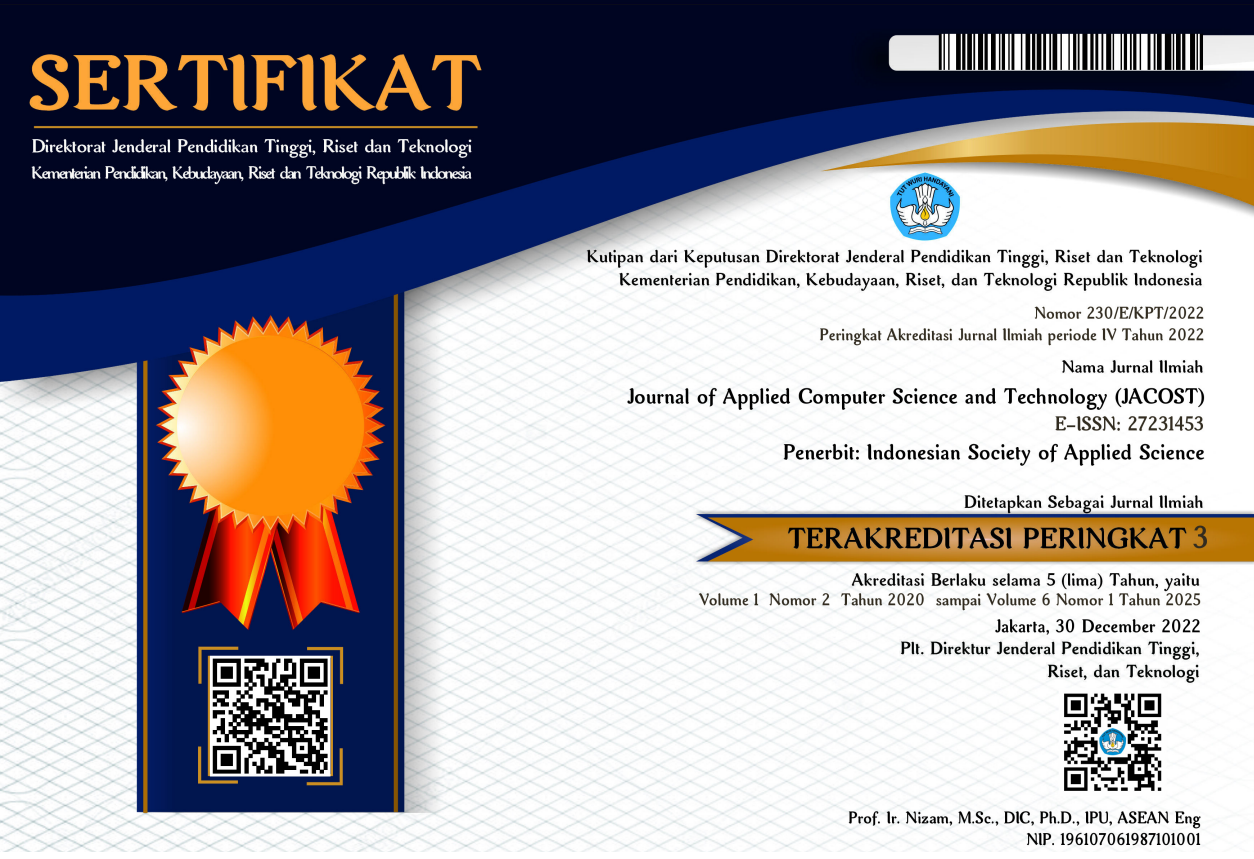Identifikasi Karakteristik Citra Berdasarkan pada Nilai Entropi dan Kontras
DOI:
https://doi.org/10.52158/jacost.v2i1.136Keywords:
image edge detection, image characteristics, regionization, entropy, contrast.Abstract
AbstractDetermining the object boundaries in an image is a necessary process, to identify the boundaries of an object with other objects as well as to define an object in the image. The acquired image is not always in good condition, on the other hand there is a lot of noise and blur. Various edge detection methods have been developed by providing noise parameters to reduce noise, and adding a blur parameter but because these parameters apply to the entire image, but lossing some edges due to these parameters. This study aims to identify the characteristics of the image region, whether the region condition is noise, blurry or otherwise sharp (clear). The step is done by dividing the four regions from the image size, then calculating the entropy value and contrast value of each formed region. The test results show that changes in region size can produce different characteristics, this is indicated by entropy and contrast values of each formed region. Thus it can be concluded that entropy and contrast can be used as a way to identify image characteristics, and dividing the image into regions provides more detailed image characteristics.
Downloads
References
E. Bourennane, P. Gouton, M. Paindavoine, F. Truchetet, ”Generalization Of Canny – Deriche Filter For Detection Of Noisy Exponential Edge”, Signal Processing, vol. 82, no. 10, pp. 1317–1328, 2002.
P. Zhou, Ye, W., & Wang, Q., ”An Improved Canny Algorithm for Edge Detection”, Journal of Computational Information Systems, vol. 7, no. 5, pp. 1516-1523, 2011.
C. Bustacara-Medina, Leonardo Florez-Valencia, Luis Carlos Diaz, ”Improved Canny Edge Detector Using Principal Curvatures”, Journal of Electrical and Electronic Engineering. vol. 8, no. 4, pp. 109-116, 2020.
J. Canny, ”A Computational Approach To Edge Detection”, IEEE on Pattern Analysis and Machine Intelligence. vol. 8, pp. 679-698, 1986.
G. Farnebäck, and Carl-Fredrik Westin, 2006. ”Improving Deriche-style Recursive Gaussian Filters”, Journal of Mathematical Imaging and Vision. vol. 26. pp. 293-299, 2006.
R. Deriche, ”Using Canny’s Criteria To Derive A Recursively Implemented Optimal Edge Detector”, Computer Vision, vol. 1, no. 2, pp. 167-187, 1987.
R.C. Gonzalez, R.E.Woods, dan S.L. Eddins, Digital Image Processing using MATLAB. Pearson Education, 2004.
P. Gouton, Hayet Laggoune, R. K. Kouassi, and Michel Paindavoine, ”Ridge-line optimal detector”, Optical Engineering, vol. 39, no. 6, pp. 1602-1611, 2000.
M. Lievin, F. Luthon, E. Keeve, ”Entropic Estimation of Noise for Medical Volume Restoration”, International Conference on Pattern Recognition, vol 3, pp. 30871, 2002.
S. Pyatykh, Hesser J, Zheng L, ”Image noise level estimation by principal component analysis”. IEEE Trans Image Process, vol. 22, no. 2, pp.687-699, 2013.
P. Fu, Changyang Li, Yong Xia, Zexuan Ji, Quansen Sun, Weidong Cai, David Dagan Feng, ”Adaptive noise estimation from highly textured hyperspectral images”, Appl. Opt. Vol.53, no.30, pp.7059-7071, October 2014.
S. Madenda, R. Missaoui, J. Vaillancourt and M. Paindavoine, ”An Enhanced Detector of Blurred and Noisy Edges”, Signal Processing for Image Enhancement and Multimedia Processing, pp. 127‐140, 2008.
R. Munir, 2004. Pengolahan Citra Digital dengan Pendekatan Algoritmik. Penerbit Informatika Bandung.
R. Dorothy, R.M. Joany, R. Joseph Rathish, S. Prabha, S. Rajendran, ”Image enhancement by Histogram Equalization”, International Journal of Nano Corrosion Science and Engineering, vol. 2, pp. 21-30, 2015.
H. Budi, dan Veronica Lusiana, ”Analisa Teknik Adaptive Histogram Equalization dan Contrast Stretching untuk Perbaikan Kualitas Citra”, Jurnal Teknologi Informasi Dinamik, vol. 19, no. 1, pp 1-10, 2014.
Downloads
Published
Issue
Section
License
Pernyataan Hak Cipta dan Lisensi
Dengan mengirimkan manuskrip ke Journal of Applied Computer Science and Technology (JACOST), penulis setuju dengan kebijakan ini. Tidak diperlukan persetujuan dokumen khusus.
- Hak cipta pada setiap artikel adalah milik penulis.
- Penulis mempertahankan semua hak mereka atas karya yang diterbitkan, tak terbatas pada hak-hak yang diatur dalam laman ini.
- Penulis mengakui bahwa Journal of Applied Computer Science and Technology (JACOST) sebagai yang pertama kali mempublikasikan dengan lisensi Creative Commons Atribusi 4.0 Internasional (CC BY-SA).
- Penulis dapat memasukan tulisan secara terpisah, mengatur distribusi non-ekskulif dari naskah yang telah terbit di jurnal ini kedalam versi yang lain (misal: dikirim ke respository institusi penulis, publikasi kedalam buku, dll), dengan mengakui bahwa naskah telah terbit pertama kali pada Journal of Applied Computer Science and Technology (JACOST);
- Penulis menjamin bahwa artikel asli, ditulis oleh penulis yang disebutkan, belum pernah dipublikasikan sebelumnya, tidak mengandung pernyataan yang melanggar hukum, tidak melanggar hak orang lain, tunduk pada hak cipta yang secara eksklusif dipegang oleh penulis.
- Jika artikel dipersiapkan bersama oleh lebih dari satu penulis, setiap penulis yang mengirimkan naskah menjamin bahwa dia telah diberi wewenang oleh semua penulis bersama untuk menyetujui hak cipta dan pemberitahuan lisensi (perjanjian) atas nama mereka, dan setuju untuk memberi tahu rekan penulis persyaratan kebijakan ini. Journal of Applied Computer Science and Technology (JACOST) tidak akan dimintai pertanggungjawaban atas apa pun yang mungkin timbul karena perselisihan internal penulis.
Lisensi :
Journal of Applied Computer Science and Technology (JACOST) diterbitkan berdasarkan ketentuan Lisensi Creative Commons Atribusi 4.0 Internasional (CC BY-SA). Lisensi ini mengizinkan setiap orang untuk :.
- Berbagi — menyalin dan menyebarluaskan kembali materi ini dalam bentuk atau format apapun;
- Adaptasi — menggubah, mengubah, dan membuat turunan dari materi ini untuk kepentingan apapun.
Lisensi :
-
Atribusi — Anda harus mencantumkan nama yang sesuai, mencantumkan tautan terhadap lisensi, dan menyatakan bahwa telah ada perubahan yang dilakukan. Anda dapat melakukan hal ini dengan cara yang sesuai, namun tidak mengisyaratkan bahwa pemberi lisensi mendukung Anda atau penggunaan Anda.
-
BerbagiSerupa — Apabila Anda menggubah, mengubah, atau membuat turunan dari materi ini, Anda harus menyebarluaskan kontribusi Anda di bawah lisensi yang sama dengan materi asli.

















